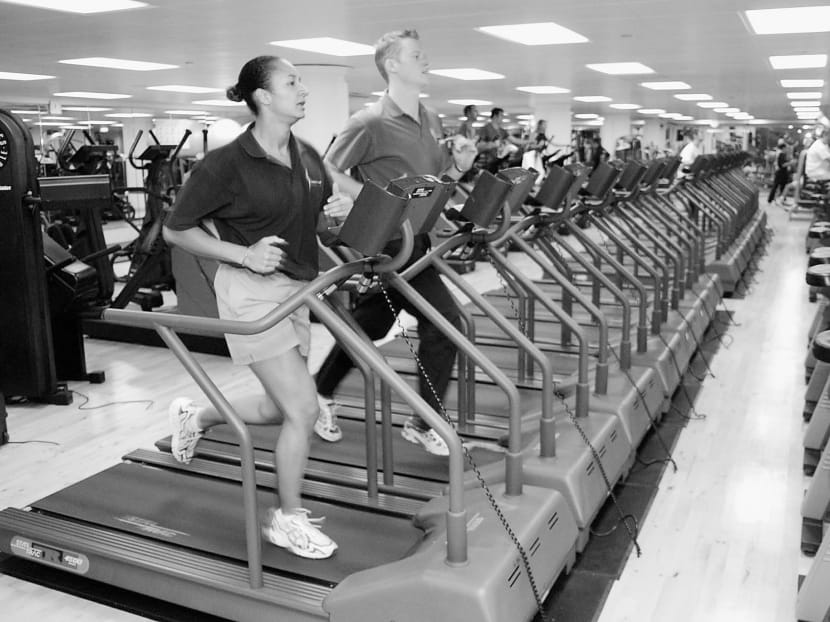The executive fad for extreme exercise has gone too far
Recently, I spent some time with an entrepreneur I know. When I previously saw him, he was training for an Ironman triathlon — that inexplicable race where you swim a couple of kilometres, then cycle as far as London to Brighton and back and finish up with a marathon.

The reason the corporate boardroom is filled with fitness fanatics is that extreme exercise and extreme success are the result of the same personality defect. Photo: Bloomberg
Recently, I spent some time with an entrepreneur I know. When I previously saw him, he was training for an Ironman triathlon — that inexplicable race where you swim a couple of kilometres, then cycle as far as London to Brighton and back and finish up with a marathon.
This time, he announced that he was going further. Marathons simply were not demanding enough for him. The previous week, he had run a marathon and a half and his Fitbit activity tracker had recorded his personal-best number of steps in a day: 50,000.
While he has been thrashing his body in this way, he has also been putting superhuman effort into building a business. The two activities, he insisted, are complementary. Stamina translates from one to the other.
The previous weekend, I had read in an interview in The Times that Ms Harriet Green, chief executive of travel firm Thomas Cook Group, likes to start her day in the gym at 5.30am hefting 16kg kettlebells and that she has energy that even her personal trainer cannot match.
Ms Green also believes that there is a link between the punishment she exerts on her body and the bottom line of her business. She builds strength in the gym, which is just what is needed to rescue a travel company in deep trouble and turn it into something that is now the object of a Harvard Business School case study.
Executives have long boasted about the rigour of their gym routines, but this extreme exercise is getting out of hand. As business gets more competitive we all talk of the need for companies to be lean and fit, agile, flexible and to sweat the small stuff.
But do we really mean that the bodies of their leaders must fit the same description?
WHY EXCESSIVE EXERCISE IS BAD
In a limited way, some exercise helps us perform at work. When I get up off my bottom and climb the stairs or ride somewhere on my bicycle, I feel less sluggish as a result. But to achieve this pleasant state of perkiness, there is no need for 16kg weights or for running 63km. Britain’s National Health Service website said all you need to do is go for a shortish, briskish walk five times a week.
And even this amount of activity is not a prerequisite to dazzling business success. The two leaders I most admire are both on the heavy side and I have never known either to take any exercise at all. Each has a large body that houses an exceptionally large brain. They both seem to have plenty of stamina for running a big, complex business, both make good decisions and are much looked up to by the many thousands of people who work for them.
It is true that these are exceptions; there are far more fitness fanatics than fatties in corporate boardrooms. Yet, the reason is not that extreme exercise causes extreme success, more that both are the result of the same personality defect.
Corporate success requires a pathological amount of motivation and discipline, as does building abs to a size that God had never intended when he fashioned Adam and Eve from clay.
The only pity is that such discipline is wasted on something so inward and pointless. Almost anything would be better — learning to play the violin, reading a book or even going shopping (as at least, you are giving the economy a boost). Sport does not broaden an executive’s world view. Virtually everything else does.
Excessive exercise is not only not necessary for success, but also a bad idea for at least four reasons.
First, it is terrible for families, because if you work long hours then exercise long hours, you really never see them at all.
Second, it is discriminatory. People who sweat together form a bond that excludes other people. It is no coincidence that Ms Green has filled her top team at Thomas Cook with a marathon runner, a triathlete and a former gymnast.
Third, it makes people feel not only superior, but also invincible in a way that can be dangerous. In business, it is quite good to feel vulnerable and well aware of your own weaknesses. Only the paranoid survive, and all that.
But my main complaint is that people who go on about their Fitbits are excruciatingly dull.
In The Financial Times about a week ago, painter David Hockney described walking through a park one day, cigarette in hand, on the way to visit his mate Lucian Freud, enjoying the sight of magpies and rabbits as he went. Three girls jogged past who, he said, did not see the magpies or rabbits as they were thinking only of their bodies.
To the painter, who at 77 knows something about stamina, a gentle stroll is far better than running not only because you look at things, but also because it is kinder on your shins. Only this final argument — that excessive exercise is bad for your bones — is one that I do not want to stoop to using. If executives choose to mess with their own skeletons in this way, let them. It is none of my business.
THE FINANCIAL TIMES
ABOUT THE AUTHOR:
Lucy Kellaway is an associate editor and management columnist at The Financial Times.






